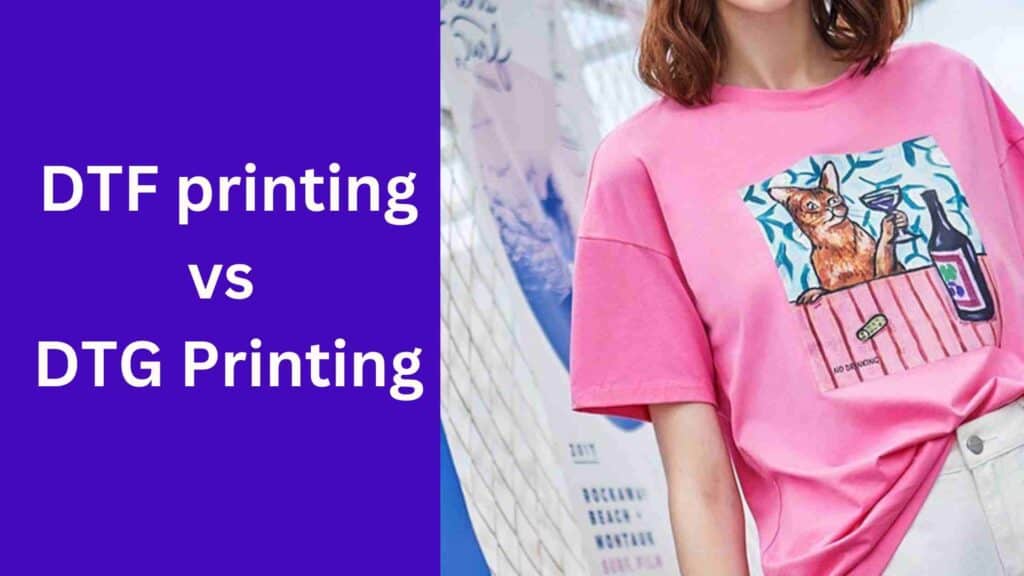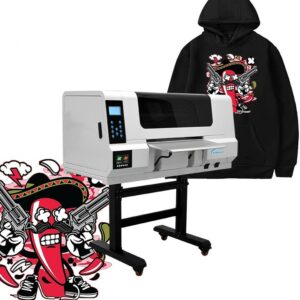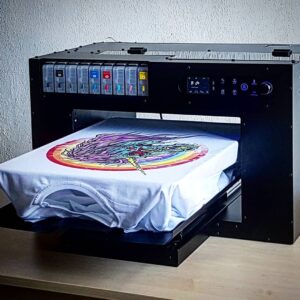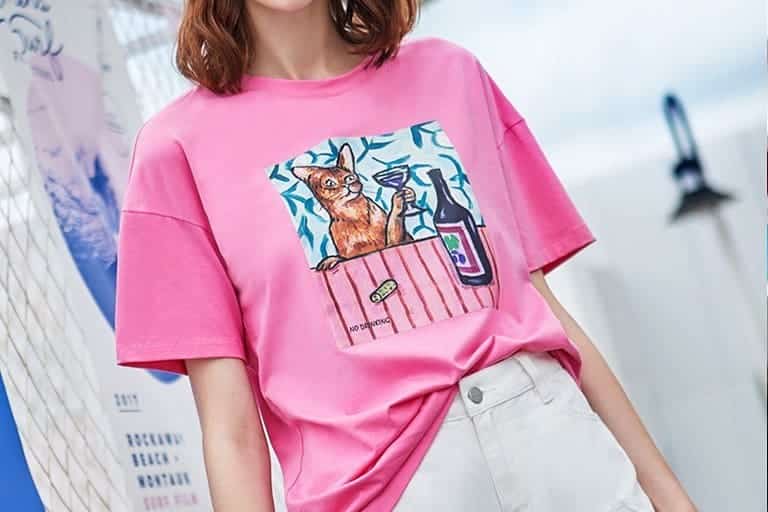DTF vs DTG printing comparison: Are you in the textile sector and seeking for the finest printing technique for your clothing designs? If so, you’ve come to the correct spot!
Due to the variety of printing choices provided by digital printing, the textile sector has undergone a revolution. Direct-to-film (DTF) and direct-to-garment (DTG) printing are two well-liked printing methods that are becoming more and more popular with clothing producers. Yet selecting the best printing technology might be difficult, particularly if you don’t understand how they vary.
This article will examine DTF vs DTG printing methods, including their advantages, disadvantages, and a thorough comparison. You’ll know which printing process is ideal for your requirements when it comes to printing on clothing. Now let’s explore the field of DTF and DTG printing to determine which printing method will offer your clothes designs the ideal appearance you want.

Differences Between DTF and DTG Printing
| Comparison Factors | DTF Printing | DTG Printing |
|---|---|---|
| Definition | Direct-to-film printing | Direct-to-garment printing. |
| Color Accuracy and Print Resolution | High resolution with sharp and vibrant colors. | Good resolution but may fade after multiple washes. |
| Durability | Can withstand multiple washes and is highly durable. | May fade or crack after multiple washes. |
| Cost-effectiveness | More cost-effective due to lower ink cost. | More expensive due to higher ink and pre-treatment solution costs. |
| Production Speed | Faster production time for large orders. | Slower production time for large orders. |
| Ink and Design Requirements | Requires different types of inks for different fabrics. | Can print on cotton-based materials using a single type of ink. |
| Type of Garment/Material | Suitable for a wide range of materials including polyester and spandex. | Suitable for cotton-based materials. |
| Design Complexity | Better suited for bold, crisp designs with solid colors. | Better suited for complex designs with multiple colors. |
| Production Volume | Suitable for both small and large-volume orders. | Ideal for small-volume orders. |
| Budget | More cost-effective and suitable for small or medium-sized businesses. | More expensive and suitable for businesses with higher budgets. |
| Timeframe | Faster turnaround time for printing jobs. | Longer turnaround time for printing jobs. |
DTF Printing
Direct-to-Film (DTF) printing is a printing technique that entails printing patterns using specialized inks onto a transparent film. The film is then heated to transfer the image to fabric. As it must properly bind with the transparent film and transfer onto the fabric, the ink utilized in this method differs from that used in other printing processes. DTF printing is often utilized in screen printing applications because it enables the printing of exact and intricate images onto the cloth.
Process of DTF Printing
The preparation of the picture, the application of the ink, and the application of heat are all steps in the DTF printing process.
Using specialist software, the design is first created by converting the picture into a printable format. The transparent film is then placed on the printing bed once the printer has been filled with ink.

The ink is applied directly to the film by the printer head as it goes back and forth across it. We get a strong and long-lasting print when the ink and the film bind together. The film is taken off the printing bed and put on the cloth when printing is finished.
The ink is then forced from the film onto the cloth by applying pressure and heat to the fabric and film in the heat press. The transparent film is removed, revealing a finely detailed pattern on the cloth.
Benefits of DTF Printing
DTF printing has a number of advantages, particularly its capacity to generate finely detailed prints even on textured textiles. Printing sophisticated graphics with many colors is also a great use for this technology.
Color accuracy and print resolution: DTF printing provides outstanding print resolution and good color fidelity. Direct ink application to the transparent film yields a finely detailed picture that can be precisely transferred to the cloth.
Durability: DTF prints are powerful and long-lasting because the ink adheres with the fabric, producing a print that can endure several washings without fading. If you need a printing method which is even more durable, you need a UV DTF printer.
Cost-effectiveness: DTF printing is a great alternative for small and medium-sized enterprises since it doesn’t need the use of pricy screens or other printing supplies. Also, it gives users the choice of printing small or big orders.
Production Speed: Because to its rapid setup and ability to create prints of excellent quality, DTF printing has a reasonably quick production speed.
Overall, DTF printing is a stable and adaptable printing process. It produces high-quality prints with good color accuracy and print resolution. It is an excellent option for small or medium-sized organizations searching for a dependable and cost-effective printing solution since it is affordable and has a quick output speed.
What is DTG Printing?
Direct-to-Garment (DTG) printing is a digital printing technique that imprints patterns directly into fabric. It uses specialized inkjet printers, producing images of exceptional quality with vivid colors and fine details. For creating high-quality, personalized t-shirts, hoodies, and other clothing, DTG printing is a popular option.
Process of DTG Printing:

The DTG printing process involves several steps, including pre-treating the garment, printing the design, and curing the ink.
To create a print that is both high-quality and long-lasting, the garment is first pre-treated with a unique solution that helps the ink adhere to the cloth. The ink is then applied directly to the garment as the printer head glides back and forth over the cloth. To ensure that the print is long-lasting and sturdy, the ink is then heated to cure it.
Benefits of DTG Printing:
High-quality prints: Even on intricate patterns and photographic pictures, DTG printing creates high-quality prints with superb color accuracy and brightness.
Flexibility: DTG printers are capable of printing on a variety of materials, including cotton, polyester mixes, and even certain kinds of silk. As a result, it’s a fantastic choice for printing on a range of clothing products, including t-shirts, hoodies, and caps.
Turnaround time: On-demand printing is possible with DTG printing, which also offers short turnaround times. Businesses who have a pressing need for prompt and effective order fulfillment can especially benefit from this.
Cost: DTG printing is more cost-effective for short print runs since it doesn’t need any setup fees, in contrast to conventional screen printing techniques. If the order volume is large, sublimation printing is a good alternative.
Environmentally friendly: DTG printing is said to be more ecologically friendly than other printing techniques since it utilizes less water, chemicals, and trash.
DTG printing is a popular option for many companies and people in the printing sector since it provides a wonderful blend of quality, adaptability, and efficiency.
Comparing DTF & DTG printing on various factors
Print Quality: DTF printing produces prints with finer details and sharper lines than DTG printing because it employs a higher resolution print head. When the ink is immediately absorbed into the transfer film, which is subsequently transferred to the fabric, the prints produced by DTF printing are also more bright.
Fabric Compatibility: DTG printing is only compatible with cotton and a few cotton mixes, but we can use DTF printing on a larger variety of textiles, including cotton, polyester, and blends. This is due to the more adaptable ink used in DTF printing, which can cling to a larger variety of materials.
Production Speed: Because there is no need to pre-treat the fabric, which is a labor-intensive step in DTG printing, DTF printing is quicker than DTG printing. DTF printing is a speedier and more effective procedure since the transfer film is simply produced before being put to the cloth using a heat press.
Color Capability: DTG printing can print many colors at once, but DTF printing has to utilize a different transfer sheet for each color. As a result, DTG printing can generate more color variants. DTG printing is thus more suited for complex patterns with many colors. On the other hand, DTF printing is better for straightforward designs with few colors.

Other Factors:
Durability: DTG printing utilizes an ink that is immediately absorbed into the fabric, while DTF printing employs a transfer sheet that may eventually peel off. DTG method produces designs that are more long-lasting and durable. The transfer sheet’s quality may have a significant influence on the print’s lifespan. DTF printing can still generate prints that are robust enough for the majority of applications.
Cost: Due to the costly pre-treatment equipment and specific inks needed for DTG printing, it is often more expensive than DTF printing. As DTF printing doesn’t need as much technology or specialist materials, it is a more cost-effective solution for smaller companies or those on a restricted budget.
Factors to consider before choosing between DTF and DTG printing
Is DTF better than DTG? Before you decide, let’s look at these deciding parameters:
The fabric or kind of clothing
The kind of garment or material to be printed on is one of the most important aspects to take into account. DTF printing is adaptable and you can use it on a variety of textiles, including polyester, spandex, and other synthetic materials.
is DTG printing good quality? DTG printing is good for cotton-based materials. DTF printing is therefore the ideal choice if the company has to print on a variety of materials.
Design difficulty
While choosing a printing technique, it’s also important to take the design’s intricacy into account. Although DTF printing is best for designs with strong, clean lines and solid colors, DTG printing is better suited for designs with a lot of color and shading. DTG printing is the preferred choice when the design includes many colors and is highly detailed.

Volume of production
Another important issue to take into account is the desired manufacturing volume. DTG printing is best for orders with less than 100 pieces, but DTF printing is appropriate for both small and big orders. DTG printing takes longer to complete than DTF printing, which makes it the superior choice for companies that must quickly meet big orders.
Money
You should also consider the budget. Because of the high price of ink and pre-treatment solutions, DTG printing is more costly than DTF printing. Because DTF printing is more affordable, it is the preferable choice for small and medium-sized organizations with tight budgets. If you want to slash the per print cost, white toner printing is a good alternative to DTF.
Duration
How long the printing process will take to finish? Although DTF printing is quicker, DTG printing takes longer to finish. DTF printing is the superior choice if the company needs a short turnaround time.
What is the lifespan of DTF?
DTF prints typically have a lifetime of two to three years before the colors start to fade or the design starts to peel or break. DTF prints may, however, survive longer with the right upkeep. It’s crucial to adhere to the printer’s cleaning recommendations and keep the garment away from abrasive detergents and extreme heat.
Are DTG printers worth it?
DTG printers often cost more than other printing technologies, but they provide high-quality prints that are appropriate for a variety of textiles and patterns. They also enable short turnaround times and on-demand printing, which is advantageous for companies that must swiftly meet orders. But, if you just have a short printing schedule or a tight budget, alternative techniques like DTF printing can be more economical for you.
Conclusion – DTG vs DTF Printing
In this post, we’ve contrasted the two widely used printing techniques, DTF and DTG. Direct-to-Film printing is known as DTF, while Direct-to-Garment printing is known as DTG. We have covered the procedure, advantages, and disadvantages of both printing techniques.
DTF printing delivers a greater resolution with bright and brilliant colors than other print technologies in terms of color accuracy and print resolution. Nevertheless, intricate patterns with various colors are best suited for DTG printing. Due to decreased ink costs, DTF printing is more cost-effective and long-lasting, but DTG printing is suitable for printing on cotton-based fabrics.
Making the appropriate printing process selection for your company’s requirements is crucial if you work in the printing sector. It is vital to take into account aspects like the kind of garment/material, design complexity, production volume, budget, and timeline when choosing between DTF and DTG printing.
The optimal printing process for your company will rely on your unique demands and requirements. Both DTF and DTG printing methods have advantages and disadvantages. In the end, it’s critical to choose a printing technique that provides the optimum mix of quality, robustness, cost-effectiveness, and output speed.
Before settling on a course of action, we advise that you thoroughly weigh your alternatives and speak with an expert. By doing this, you can make sure that you are using the ideal printing technique for your company’s requirements. These all points help you get the greatest outcomes.
FAQs
Direct-to-Film printing, or DTF, is the process of printing graphics directly onto a specific film and then utilizing a heat press to transfer those images onto clothing.
Direct-to-Garment printing, or DTG for short, is the process of printing graphics directly onto clothing using a specialized printer that deposits ink right into the fabric.
Since DTF printing utilizes a white underbase layer, which guarantees that colors seem bright and true to the original design, it is more suited for printing on dark materials.
Because DTG printing doesn’t need a white underbase layer and can produce subtler color shifts, it is more suited for printing on light materials.
Although DTG printing is better suited for intricate patterns with many colors, DTF printing delivers greater resolution with sharper and more brilliant colors.
DTF printing employs a thicker layer of ink that is resistant to fading, cracking, and peeling, making it more durable than DTG printing.
As DTF printing uses less ink and is preferable for mass production, it is more economical than DTG printing.
Due to the lack of the additional step of transferring the design onto a film before putting it to the garment, DTG printing is often quicker than DTF printing.
You may print on a variety of textiles, including cotton, polyester, and mixes, using both DTF and DTG printing.
Due to the use of non-toxic, environmentally friendly water-based inks, both DTF and DTG printing techniques are comparatively eco-friendly. Nevertheless, since transfer films are used, DTF printing could result in additional waste.

Ashley Wang is a skilled sales manager with knowledge in DTF printing. She presently works for ShenLan Digital, a reputable DTF printer maker. Ashley is the best person to offer advice on selecting the most suitable DTF printer because she has tested a lot of them. She launched DTFPrinterSchool to educate individuals and organizations about DTF printing technology, providing her expertise and observations on the most recent advancements in the sector. Ashley is an invaluable resource for businesses and individuals wishing to invest in DTF printing technology because of her expertise and experience in the industry.
